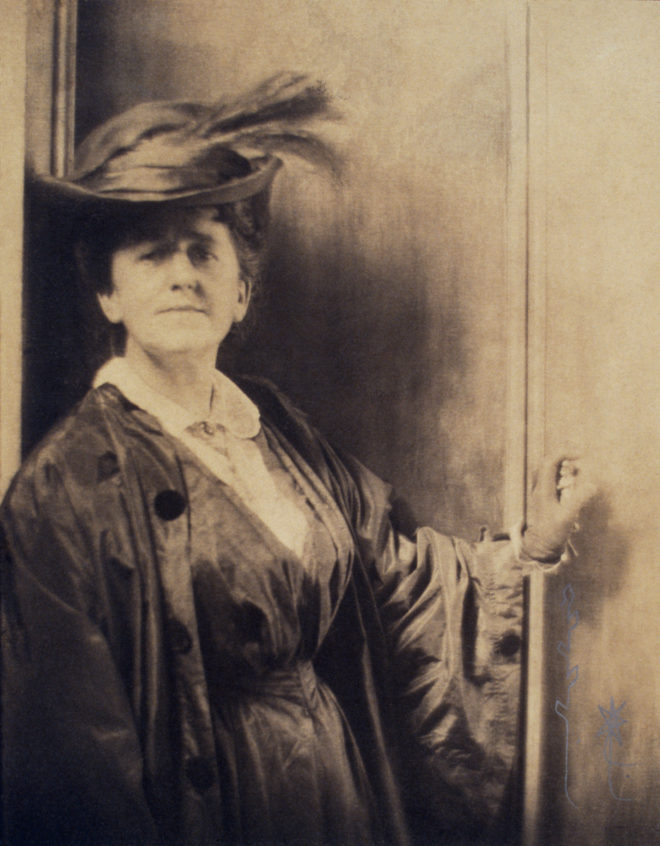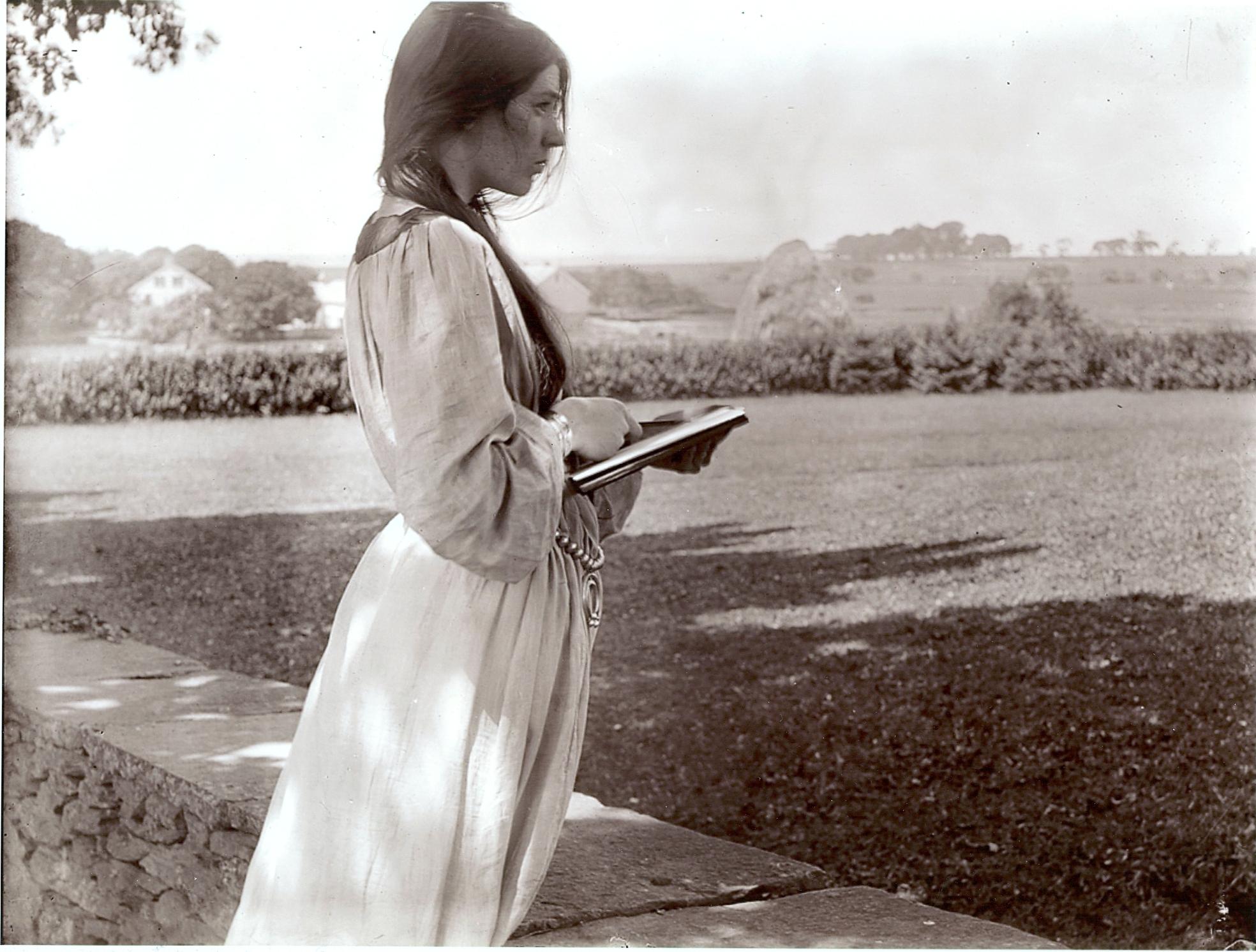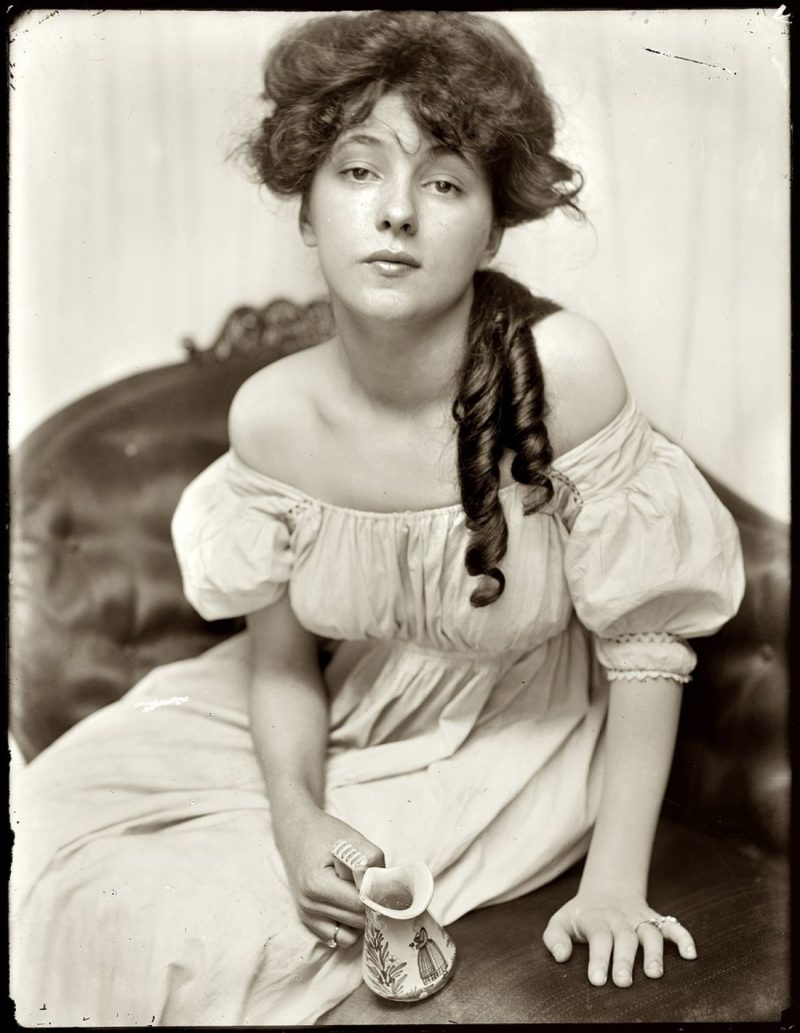Gertrude Käsebier
1852-1934
Inductee Sponsor: Joyce Wilson
About
Gertrude Käsebier was born Gertrude Stanton on May 18, 1852, in Fort Des Moines, Iowa, now known as Des Moines. Her father, John W. Stanton, in 1859, opened a sawmill in Eureka Gulch, in Colorado Territory, with hopes to prosper from the gold rush. He did.


In 1860 Gertrude, her mother and infant son, Charles, traveled to join him. Stanton’s success gave him a good local reputation. That same year, he was elected first mayor of Golden, a small mining village that was the capital of Colorado Territory. The Stanton’s newfound wealth and social status prompted Gertrude’s mother and father to encourage their daughter to become a musician. However, Gertrude was resistant. Her mother later remarked that the child was simply crazy about pictures, while no persuasion or threat could make her take up the study of the piano. In reference to one of the family’s paintings, her mother also stated that she would often see Gertrude on one knee on the floor viewing the painting through her small hands, telescope-like, talking to herself meanwhile, asking herself if it would ever be possible for her to make such a picture. On other occasions, Gertrude would even attempt to draw with water that had been spilled on the floor. It was not until years later when Gertrude married and raised three children that her childhood dreams would be fulfilled.
The Civil War forced the Stanton family out of the Colorado Territory. They relocated in Brooklyn, New York in 1864. Mr. Stanton continued to prosper with work processing minerals and Mrs. Stanton took boarders into their home for additional income. From 1868 until 1870, Gertrude attended the Moravian Seminary for Women, the first and considered the best school for women, while living with her maternal grandmother in Bethlehem, Pennsylvania. Throughout Gertrude’s childhood and young adult years, she considered was an independent, spirited character.
Gertrude met Eduard Käsebier during one of his travels to New York. Before he settled there, he resided in a room at the Stanton home. Eduard Käsebier was from a wealthy German family and had decided to make his own fortune in the United States. With his background in chemistry and business, Eduard became a successful shellac importer. Gertrude married Eduard Käsebier on her twenty-second birthday. Her mother was happy with the announcement and believed that Gertrude might finally settle and raise a family. She believed that Käsebier was a good man who would be a loyal husband, a good father and a good provider. Gertrude’s independence and spirit remained. She did raise three children, Frederick William, born 1875, Gertrude Elizabeth, 1878, and Hermine Mathilde, born 1880, but she did not have the patience for housework and consistently maintained that she wanted to be an artist. Eventually, the inability for Gertrude and Eduard to give into each other caused a considerable distance between them. Later, Gertrude recalled her decision to marry Eduard as a mistake, as she was on the rebound and Eduard made a nice proposal. The marriage itself was terrible. If my husband has gone to Heaven, I want to go to Hell. Nothing was ever good for him. Author Barbara L. Michaels states that where Eduard was traditional and reserved, Gertrude was original and vivacious. Thus, most of their lives were spent apart and finally, after the children had reached adolescence, Eduard supported Gertrude to attend art school and many her travels to Europe.
Originally, Gertrude wanted to be a portrait painter. She thus enrolled in and attended the Pratt Institute from 1889 to 1893. There she studied drawing and painting. The school did not offer photography; Käsebier had taken photographs before she enrolled in the school and used the school’s library to further her knowledge and improve her techniques of photography. By 1894, Käsebier was heavily involved with photography in addition to her painting and drawing.
In the spring of 1894 she won two photography contests. A fifty-dollar prize for best photograph was awarded her from The Quarterly Illustrator for best photograph. She won the runner-up in the New York Herald. This inspired Käsebier and for the first time she began to consider photography as a career. Later in 1894, Käsebier took a yearlong trip to Europe to broaden her study of photography and painting. Initially, Käsebier photographed and painted city scenes and landscapes; however, she began to shift her focus to portraiture during an extended stay in France. Hitherto I had given to in-door portraiture no attention whatsoever. But one day when it was too rainy to go into the fields to paint, I made a time exposure in the house, simply as an experiment. The result was so surprising to me that from that moment I knew I had found my vocation. Soon thereafter she was publishing photographs and essays in French magazines. On a trip to Germany that same year, Käsebier spent some time studying under Hermann Wilhelm Vogel, the very chemist with whom that Stieglitz had worked. That year was extremely important to Käsebier’s growth as a photographic artist, but word of her husband’s ill health brought her back to New York.
Eduard was given a year to live; although, he lived on for twelve years. For additional family income and to further her career in photography, Käsebier was encouraged to open her own studio. She worked under Samuel Lifshey at the Brooklyn Photographic Studio to learn the business of running a studio. In late 1985, she opened her studio in New York. To recruit business, Käsebier began exhibiting her photographs; her first exhibit was held at the Boston Camera Club in February 1896. She also exhibited over 150 images at the Pratt Institute.
Käsebier’s portrait style became increasingly popular and her studio was a great success. She had a sense about revealing the subject; she also she used very few props and simple backgrounds. One of the most difficult things to learn in painting is what to leave out. How to keep things simple enough. The same applies to photography. The value of composition cannot be overestimated; upon it depends the harmony and sentiment. Käsebier photographed some of New York’s most recognized people, but she also had an interest in photographing Native American Indians. In fact, some of these portraits became her most famous. While a young girl in Colorado, she was one of the few white children. Most of her friends consisted of American Indian children. This instilled an appreciation for the people who would eventually be chased from their homes in America. Käsebier rarely photographed her American Indian friends in costume. I want a real raw Indian for a change…the kind I used to see when I was a child. She was not the first to begin an extensive photographic documentation of American Indians, but hers were more artistically motivated.
As Käsebier’s portraiture came more into the light of the art world, she soon sought a friendship with Alfred Stieglitz. Near the turn of century, Käsebier contacted Stieglitz: to further he success by mingling with the art photographers, to further her knowledge and to give herself news directions in her life. The two befriended quickly. They agreed that photography was a form of artistic expression and worked with similar processes in order to achieve an artistic photographic print. Within a short period of time, Stieglitz was promoting Käsebier ’s work through his publication, Camera Notes, and organizing solo exhibitions of her work, one of which was the Camera Club of New York, which Käsebier soon became a member. The most important and now historic exhibit of this period was the first Philadelphia Photographic Salon of 1898. Of the 1200 entries, only 259 were selected. Ten of Käsebier ’s images were chosen to exhibit; this extremely high honor placed her in the ranks of Stieglitz and other contemporaries. The judges of the exhibit, such as William Merritt Chase stated that Käsebier ’s work was as fine as anything that VanDyck has ever done. Charles H. Caffin was taken by Käsebier ’s individuality…the force and distinctiveness of her style. The following year, Käsebier was a judge on the Philadelphia Photographic Salon. About that same time, her print The Manger sold for $100, which was the most paid for a photograph at that time. Käsebier began to socialize with F. Holland Day, Clarence White and became one of photography’s most influential photographers due to her unique style and consistently good work.
These events set forth a new direction for Käsebier. By 1901, Käsebier had been exhibited in the Frances Benjamin Johnston’s exhibit of women photographers, which was organized for the Paris Exposition, and she also showed in F. Holland Day’s new School of American Photography, opening in London and traveling to Paris. She was also the first female elected to The Linked Ring. This was a group organized in 1892, with original members of George Davison, Alfred Horsley Hinton, Maskell, Lydell Sawyer, and Henry Peach Robinson. Members were by invitation only and sought to pursue the development of the highest form of Art of which Photography was capable. Käsebier also began lecturing and publishing her work in other magazines such as Everybody’s Magazine, The World’s Work, The Ladies Home Journal and The Craftsmen.
In 1901, Käsebier took some time away from the American scene and traveled to Paris with Edward Steichen. There she took numerous photographs of Auguste Rodin. This same year, Käsebier was the subject of a chapter in Charles H. Caffin’s Photography as Fine Art. With all of her close associations, particularly with Stieglitz, Käsebier also became one of the founding members of the Photo-Secession group. Stieglitz was the leader of the group, but he was able to form this group with the support of people such as Käsebier , Edward Steichen, Clarence White, and others. Stieglitz’s direction allowed the group to open the 291 gallery and begin the publication Camera Work. The first issue, released in late 1902, had six illustrations and two articles by Gertrude Käsebier . By 1905, Käsebier ’s health began to falter. Tensions between her and Stieglitz about Camera Work began to grow and Eduard Käsebier had decided to move, he abruptly sold the house and relocated in Oceanside, Long Island.
Although Käsebier remained in association with the Photo-Secession for several years thereafter, by 1908, the friendship with Stieglitz was finally dissolved. Also by this time, she had resigned from The Linked Ring. Her husband, Eduard Käsebier , died on December 17, 1909. Käsebier continued to participate in the Photo-Secession group exhibits and had some prints published in Camera Work. She continued teaching and her professional portrait photography, and participating in other exhibits such as the International Exhibit of Pictorial Photography, and teaching. By 1912, Käsebier officially resigned from the Photo-Secession group.
Käsebier combined home and studio, by 1914, to an apartment on West 71st Street in New York. Throughout her career she was primarily interested in portraiture and creating photographic images with motherhood as an overwhelming theme. During her later years, she began to take her camera outdoors, although never leaving behind her portraiture. In 1916, she was a founding member of Pictorial Photographers of America and continued exhibiting her work. About 1925, Käsebier ’s sight began to fail her and, by 1929, she had to close the studio. By this time she was also almost completely deaf. As a young girl she lost her hearing in one ear, and the other ear had finally weakened from so many years of straining. She died of “old age” on October 13, 1934.
In 1979, Gertrude Käsebier was inducted into the International Photography Hall of Fame and Museum. In street clothes, about 1900, she would have looked like other upper middle-class matrons: corseted, hatted and gloved. In a fur-trimmed gown in the family portrait or in silvery gray silk and lace with diamond ornaments at her daughter’s wedding in 1899, she might even have been called elegant. But her hands told another story. Not her palms, but her fingertips, which bore the marks of nonconformism: stains from photographic chemicals, and, in later years, tinges of nicotine from the little “in between acts” cigars that so embarrassed her pre-adolescent granddaughter. A motion picture of Käsebier made early in her career would have shown an energetic woman carrying herself erectly, moving quickly, and frequently brushing a stray strand of graying hair from her brow.
By Lori Oden For IPHF

